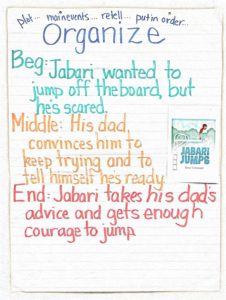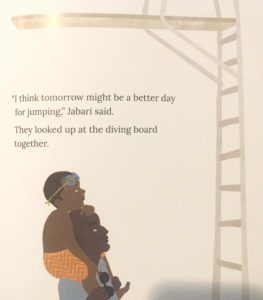I am always on the hunt for mentor texts that all students can relate to and this one fits that to a tee! And of course, the front cover had me from the beginning!
Why I Finished It
Of course you have to finish it to see if Jabari actually jumps. He really wants to jump off the board, but without announcing his fear, he makes excuses for not jumping. His father quietly supports his son and provides advice. Jabari and his dad are instantly likable and you almost just want to hug sweet Jabari.
Who I Would Give It To
This is a short story with a big punch! I love it! This book should be required for all elementary classrooms. There is so much to it!
Interested in a week long plan for Jabari Jumps with all the materials?
Integration Ideas
Writers’ Workshop: Generating Ideas (Text-to-self connections)
I am always emphasizing that when you read stories for generating ideas, you should read it all the way through. Then let students think of any connections they have to the story. Allow them time to get those stories out and write down their seed ideas for future writing. Next, I provide one or two prompting questions to help them generate ideas. After the questions are given, I allow time for students to talk a bit and then write down their seed ideas. Some prompts you might use for this book are: What was something scary you tried to do? Who supports you when you are frightened to try things?
Making Predictions
This story really lends itself to making predictions. I usually stop on the page with Jabari stretching before he attempts to jump and ask the students if they think he will jump. Why or why not? Then I stop again when they decide tomorrow might be a better day and predict again. Then I stop on day two when he walks to the end of the board and ask if they think he’ll jump. Then at the end of the story, Jabari says he will do double backflips soon. Have students make predictions about his statement.
Writers’ Workshop: Organization & Readers’ Workshop: Retell a Story
In Writers’ Workshop, students have to organize their writing. If students are writing a personal narrative, they need to make sure their story has a beginning, middle, and end. Luckily this is also a reading skill! Students have to retell the story and then learn how to organize their own stories. Once I read this story to the students we practice saying out loud what happened in the beginning, what happened in the middle, and what happened in the end. We repeat our retell out loud multiple times. This makes a great anchor chart! (Click here for more ideas on retelling). Next, we move this into Writers’ Workshop. I have the students divide a piece of paper in three, and practice telling their stories first. What happened in the beginning, what happened in the middle, and what happened in the end. They need to say their story out loud at least four times before writing!
Characterization
Jabari is a great character to get students to discuss his actions and what they mean. He doesn’t say he’s scared, but he procrastinates by stretching and says he’s a little tired so he probably won’t jump that day. This is a great time to talk with students about characters’ actions. And, of course, Jabari definitely undergoes a change in the courage department, so this is a great place to discuss how a character changes over the course of the story.
Jabari’s dad has many positive character traits that he displays through speech and action. Have students talk about his traits. Jabari’s dad is patient, kind, supportive, and encouraging. Those are not words the students will provide. So let students say things like nice and kind. Then create a chart and help them brainstorm “better” words to describe his dad. After each word, ask students to use the word when they talk and write (word choice). Check out our character cards to help improve vocabulary.
Writing Conventions: Quotations (dialogue)
There is a lot of dialogue in this book, so if you have to teach the conventions of quotations, this is a great mentor text. 
Show this page to the students, so that everyone can see it. Ask what they notice. After students respond with what they see, ask students who is talking? How do you know? Continue discussion until students realize that Jabari is speaking. Make sure students use text clues and evidence to explain and justify. Then continue discussions about where the quotation marks are located and where the comma is. Next, as in all Writers’ Workshops, have students go into their own writing to make sure they have punctuated their dialogue correctly.
How do you use this story?
Interested in Mentor Text training? Contact us!







Would love to read this to my sons!